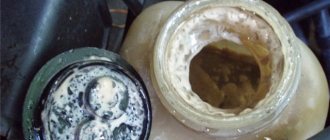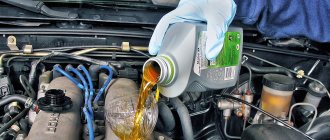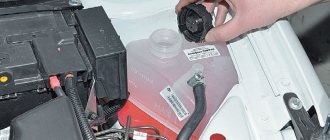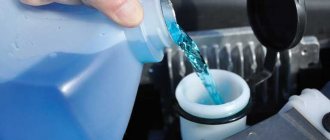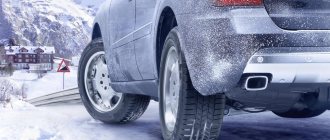In this article we wanted to tell you about the age-old question: “What are antifreeze and antifreeze and can they be mixed with each other? This article will be useful for everyone who has not yet understood this issue. If you are an expert, then this article is not for you.
On the Internet you can find a lot of videos in which when mixing antifreeze and antifreeze, a lot of foam is formed and it directly floods the entire vessel and begins to erupt from it.
But not many people know that this is all fake. This is what autobloggers do to get coveted views and subscribers. Unfortunately, few people know that in fact, when mixing antifreeze and antifreeze, practically nothing happens, at least visible to the human eye.
After reading the article to the end, you can finally decide what is better antifreeze or antifreeze?
On the Internet you can find a large number of articles that praise only antifreeze, and the same number - antifreeze. But let's still look into this issue. Let's go into theory a little, let's not call such concepts as antifreeze or antifreeze, but let's just call it all just coolant.
The base coolant consists of ethylene glycol, water, dye and additives. The base can be ethylene glycol and in modern antifreezes propylene glycol, respectively, distilled water in order to stir to the desired concentration, dye.
Ethylene glycol itself is transparent in color; the dye is needed only to recognize what brand of coolant and additive package it is. That's all the salt in the additive package. The additive package performs anti-foaming, anti-corrosion and lubricating functions.
This article will also help you understand the difference between antifreeze and antifreeze.
Coolant quantity VAZ 2107
So, how much antifreeze or other coolant should be poured into the VAZ 2107? According to the instructions, you need to use 9.85 liters, which means that you need to purchase 10 liters of coolant. However, what exactly should you choose – antifreeze or antifreeze? There is simply no clear answer to this question. Many drivers prefer antifreeze exclusively. It is sold ready for use or in concentrated form. In one of the articles on the Avtopub website we will definitely look at the advantages of this choice. Let's proceed to the procedure for replacing the coolant in a VAZ 2107 (VAZ 2101, VAZ 2102, VAZ 2103, VAZ 2104, VAZ 2105, VAZ 2106).
How to drain antifreeze in a VAZ 2107 and replace it
Before draining the antifreeze, you need to fully open the heating tap inside the car using the appropriate lever, which should be set to the rightmost position.
In the lower left part of the radiator there is a drain plug, which also needs to be unscrewed. After this, it is necessary to drain the antifreeze into a previously prepared container of the appropriate volume. If your car has an old radiator, you will not be able to find this plug. Instead, you need to unscrew the fan switch sensor, for which you need to use a 30 mm wrench.
Don’t know how antifreeze differs from antifreeze? Read ours.
Draining the VAZ 2107 antifreeze is only half the battle. After this, you need to tighten all the plugs and loosen the clamp using a screwdriver, and also remove the rubber hose from the intake manifold fitting. This must be done in order to prevent the appearance of an air lock.
After this, you need to fill in the selected coolant. Immediately after antifreeze begins to flow out of the fitting, put a hose on it and tighten the clamp thoroughly. Then add the required amount of coolant to the radiator and tighten the appropriate cap.
The next step is to fill the coolant into the expansion tank. The recommended amount is approximately 3-4 centimeters above the “MIN” designation.
If there is dirt in the cooling system of the car, it must be cleaned using plain water or appropriate means. The procedure for flushing a car's cooling system is no different from the procedure for replacing the coolant in a VAZ 2107 - drain the antifreeze, add a new one, get rid of the air, start the engine, and then drain it. We repeat the procedure several times until water without any impurities begins to flow out of the engine block and radiator.
Now you know how to drain antifreeze on a VAZ 2107 and how much antifreeze you need to use.
On VAZ cars from 2101 to VAZ 2107, in general, all the classics. This process of changing the coolant on all VAZ models is very similar to the replacement process on other cars of the Zhiguli family.
VAZ 2110 | Antifreeze | Lada
Antifreeze
The cooling system is filled year-round with a mixture of water and antifreeze with an anti-corrosion additive from the VW/SEAT concern. This mixture prevents freezing and corrosion of the cooling system, salt deposits and, in addition, increases the boiling point of the coolant. In the circulation circuit, as a result of the expansion of the liquid when heated, increased pressure is created, which also contributes to an increase in the boiling point of the coolant. The pressure is limited by a valve located in the expansion tank cap, which opens at a pressure of 1.4 - 1.6 bar. For the engine cooling system to function flawlessly, a high boiling point of the coolant is required. If the boiling point is too low, vapor locks can form, causing poor engine cooling. Therefore, the cooling system must be filled with a mixture of water and antifreeze all year round.
It is necessary to use antifreeze G12 Plus (purple color, exact designation G 012 A8F) or another con, for example, Glysantin-Alu-Protect-Premium/G30.
If the cooling system is filled with a mixture containing G12 antifreeze (red, exact designation G 012 A8D), then red G12 antifreeze or another con, for example, Glysantin-Alu-Protect/G30, can also be used to replenish the coolant level. Note: G12 purple can be mixed with G12 red.
Caution: Do not mix red G12 antifreeze with the older green G11 antifreeze, as this can cause severe engine damage. The coolant is brown (the result of mixing antifreeze G12 and G11), replace it immediately.
Note: If a liquid with an antifreeze additive of the wrong specification accidentally ends up in the cooling system, the system must be flushed. To do this, all liquid from the cooling system should be completely drained and the system filled with clean water. Leave the engine idling for two minutes. Drain the water again and blow out the system from the side of the expansion tank with compressed air to completely empty it. Close the drain plug and fill the cooling system with a mixture of water and G12-Plus antifreeze.
Attention: To replenish the cooling system (also in the warm season), only use a mixture of G12-Plus (purple) with soft, clean water. The proportion of antifreeze, also in summer, should not be lower than 40%. Therefore, when refilling the cooling system Antifreeze should always be added to water.
In our latitudes, the coolant should provide protection against freezing down to -25 °C, or even better - down to -35 °C. The proportion of antifreeze should not exceed 60% (antifreeze protection of the coolant down to -40 °C), otherwise the antifreeze protection and cooling effect of the liquid are reduced. Note: depending on the vehicle equipment, the amount of coolant added may differ slightly from the values indicated in the table
Ratio of coolant components in liters
Frost protection
Selection of coolant for VAZ 2101 - 2107
First, you need to decide on the type of coolant, as well as the amount that will be sufficient for the car. If you have any questions regarding the quantity, open the instructions, it requires 9.85 liters
, which means you need to buy 10 liters of antifreeze or antifreeze. But it’s unlikely that you’ll be able to decide quickly whether antifreeze or antifreeze is better. And then the question arises: “What to fill in?” Antifreeze or antifreeze? There is no consensus.
Personally, I use antifreeze. It has several advantages: it is possible to buy a ready-made solution that can be used immediately. Or concentrate and dilute it with distilled water, in this case it is necessary to maintain a ratio of 50 to 50. There is an article on the site that talks about, you can also view information on the Internet.
Regarding the tool... You will need:
a spanner wrench set to “13”, a screwdriver, as well as a container into which we will drain the old coolant (a wrench set to “30” may also come in handy).
Features of antifreeze and antifreeze
Let's start with the fact that Tosol is a type of antifreeze. developed in the USSR. But as often happens with us, the name has become a household word and many liquids for car cooling systems are called Antifreeze.
Antifreeze and antifreeze are based on ethylene glycol (less commonly propylene glycol), distilled water and various additives. And the main difference between them comes down to the additive package.
Antifreeze is made from equal parts of water and ethylene glycol using traditional technology, which includes additives based on salts of inorganic acids.
But antifreeze already includes carboxylate additives (from salts of organic acids).
Thanks to additives, these liquids have anti-cavitation, anti-foam and anti-corrosion properties.
But the traditional manufacturing technology that is used in the production of Antifreeze is already somewhat outdated due to additives. Additives made from salts of inorganic acids cease to perform their functions over time. Antifreeze has a longer additive life.
At the same time, the additives themselves work differently. The anti-corrosion additive in Antifreeze covers all metal elements of the system with a thin protective layer. But this same layer makes it difficult to remove heat.
In antifreeze, this layer is much thinner than that of Antifreeze, and at the same time it covers only those elements of the system that are susceptible to corrosion.
If you look at it in general, then in a debate - antifreeze or antifreeze for VAZ, in terms of its performance properties, antifreeze wins. But not everything is so simple and a lot depends on the VAZ model itself.
The fact is that most domestic cars are primarily designed to work with Antifreeze. It is the main liquid, although the operating instructions often indicate that antifreeze can also be used.
Draining antifreeze from the radiator
The replacement process itself is very simple, but I will describe it.
Before you start draining the old liquid, be sure to move the heating tap control lever to the rightmost position, only after that the tap will open. The expansion tank cap is unscrewed, and the filler cap is also unscrewed.
We carefully inspect the lower left corner of the radiator, there we find the drain plug and unscrew it, pouring the liquid into the prepared container.
It is worth remembering that old-style radiators do not have such a plug. It is replaced by a fan switch sensor, take the key to “30” and unscrew it. If you had it produced, then you will find it there.
We also find a plug on the engine itself; it can be unscrewed with a key set to “13”. When you have already drained all the liquid, you need to screw back all the drain plugs.
In order to avoid the formation of an air lock in the system, you need to unscrew the clamp with a screwdriver, then remove the hose from the intake manifold fitting.
Replacing antifreeze VAZ2107 injector
According to the manufacturer's recommendation, the coolant should be replaced after two years of operation or after 60 thousand kilometers, whichever comes first. In addition, if the coolant changes color to a reddish color, replace it immediately, as this indicates that inhibitory additives have developed and the fluid has become aggressive towards the parts of the cooling system. key “13”, coolant, clean rag, container for drained coolant with a capacity of at least 10 liters. Use coolants recommended by the manufacturer (see Appendix 2). Replace coolant only when the engine is cold. Coolant is toxic, so be careful when handling it. When starting the engine, the radiator cap must be closed. Screw the radiator cap tightly. The radiator of the cooling system is under pressure when the engine is running, so coolant may leak from under a loosely tightened cap. 1. Place the car on a flat, horizontal platform. If the site is sloped, position the vehicle so that the front is higher than the rear. Antifreeze is poisonous. Therefore, in order not to pollute the environment, drain it from the radiator through a funnel (for example, made from a plastic bottle). 6. Remove the expansion tank cap and the cooling system radiator cap by turning them counterclockwise. 7. Remove the plug from the drain hole on the cylinder block, first placing a container under it, and drain the remaining coolant from the channels of the cylinder block. Tighten the plug. 8. To drain the remaining fluid from the expansion tank, unfasten its fastening belt and, with the plug open, lift the tank and drain the fluid through the radiator. 10. Fill the engine cooling system by pouring coolant into the radiator until the level is at the lower edge of the radiator filler neck. Then pour liquid into the expansion tank until the liquid begins to flow from the liquid hose of the tank into the radiator neck. In this case, the liquid level in the expansion tank will be approximately 3-4 cm above the “MAX” mark on the wall of the tank. Close the expansion tank and radiator caps. Start the engine and let it warm up to operating temperature (before turning on the electric fan, if installed on the car). After this, stop the engine, check the coolant level and, if necessary, add it to the expansion tank to the “MAX” mark. With the engine running, monitor the coolant temperature according to the gauge. If the arrow reaches the red zone and the fan does not turn on, turn on the heater and check what kind of air flows through it. If the heater supplies heated air, most likely the fan is faulty, and if it is cold, an air lock has formed in the engine cooling system. To remove it, turn off the engine, let it cool and unscrew the radiator cap. Start the engine, let it run for 3 - 5 minutes and tighten the radiator cap. To ensure that air is removed from the cooling system of an injection engine, before adding liquid, disconnect the hose from the throttle assembly. When pouring liquid into the radiator, at the moment the liquid begins to flow out of the throttle body pipe, put the hose on the pipe and tighten the hose clamp.
Let's talk about how the coolant is replaced, aka antifreeze or antifreeze on VAZ cars from 2101 to VAZ 2107, in general, all the classics. This process of changing the coolant on all VAZ models is very similar to the replacement process on other cars of the Zhiguli family. First, you need to decide on the type of coolant, as well as the amount that will be sufficient for the car. If you have any questions regarding the quantity, open the instructions, it requires 9.85 liters, which means you need to buy 10 liters of antifreeze or antifreeze. But it’s unlikely that you’ll be able to decide quickly whether antifreeze or antifreeze is better. And then the question arises: “What to fill in?” Antifreeze or antifreeze? There is no consensus. Personally, I use antifreeze. It has several advantages: it is possible to buy a ready-made solution that can be used immediately. Or concentrate and dilute it with distilled water, in this case it is necessary to maintain a ratio of 50 to 50. There is an article on the site that talks about antifreeze, you can also view information on the Internet. Before you start draining the old liquid, be sure to move the heating tap control lever to the rightmost position, only after that the tap will open. The expansion tank cap is unscrewed, and the filler cap is also unscrewed. We carefully inspect the lower left corner of the radiator, there we find the drain plug and unscrew it, pouring the liquid into the prepared container. We also find a plug on the engine itself; it can be unscrewed with a key set to “13”. When you have already drained all the liquid, you need to screw back all the drain plugs. That's all, now you can fill in antifreeze. As soon as the liquid begins to flow out of the fitting, you can already put on the hose and tighten the clamp. Afterwards, the radiator is completely filled and the cap is tightened. Antifreeze is poured according to the level, this is 3-4 cm from the MIN mark. Afterwards, the engine starts, warms up to operating temperature, turns off and the antifreeze level is checked again. If necessary, add more.
When operating a VAZ 2107 car, there may be a need to replace the coolant. This may be due to the fact that there were some problems with the cooling system and now the fluid needs to be replaced. It can be like antifreeze or antifreeze, by the way, we have already discussed how they differ in this article. I would like to immediately draw your attention to the fact that the VAZ 2107 requires 9.85 liters of coolant. Therefore, you need to purchase at least 10 liters. — Now you need to unscrew the expansion tank cap and the filler plug on the radiator. You should do this carefully, because if you warmed up the car too much before doing this, coolant under pressure may rush out, thereby creating a risk of burns. Therefore, you should not unscrew these plugs immediately after a long trip, it is better to wait 5-10 minutes - on the left side in the lower corner of the radiator there is a drain plug (image 2), you should unscrew it and drain the coolant into the container that you have prepared for this . It is worth noting that on old radiators there is no such plug, then you will have to take the key to “30” and unscrew the temperature sensor (image 3), which is responsible for turning on the fan, the coolant will flow out of it and flow out of the radiator. — There is also a drain plug on the engine block. It should also be unscrewed with a key to “13” (image 1) - After you have drained the coolant from everywhere, you need to screw the drain plugs into place, and to prevent an air lock from forming when we fill in the coolant, you should loosen the clamp with a screwdriver to remove rubber hose from the intake manifold fitting (image 4) - now you can fill in the coolant antifreeze or antifreeze whichever you prefer, after the liquid starts flowing out of the fitting you should put the hose back on it and tighten the clamp. After this, completely fill the radiator and tighten the cap. After this, you should pour antifreeze or antifreeze into the expansion tank (see image 5), the ideal level is between the MIN and MAX marks - now that everything is filled and tightened, you should start the engine and warm it up to operating temperature, waiting for the fan to turn on. This is very important, you must check that the fan is working, otherwise you may inadvertently overheat the engine, which will lead to very bad consequences. — after the engine has been warmed up to operating temperature, you should check the level and top up if necessary, again you should do this carefully since the coolant is under pressure and very hot. This technique is suitable not only for replacing coolant, but also for flushing it. The meaning is approximately the same, drain, fill in the rinse, tighten. We start the engine for a while, letting the flush circulate through the cooling system and drain it, pouring coolant in its place.
Replacing antifreeze for VAZ 2107 carburetor
Replacing antifreeze in the engine cooling system is an event that is performed at certain intervals in order to maintain efficient operation of the cooling system. Today you will learn how to drain and change antifreeze on a VAZ 2107 and why this is done. The cooling system of many modern cars is liquid. That is, heat transfer is carried out by a liquid that circulates through a system of tubes and, cooling in the radiator, returns back to the engine to receive a new portion of heat. The VAZ 2107 engine cooling system initially used water, but later, due to reduced resistance to negative temperatures, it was replaced with antifreeze. Antifreeze, compared to water, has good resistance to frost and does not freeze at all. In addition, it is not a source of scale, which means it does not clog the cooling system. In the process of constant temperature exposure, antifreeze may lose its properties. That is, first of all, its boiling point decreases and becomes equal to the boiling point of ordinary water. Secondly, such liquid can easily freeze and cause a cracked reservoir, and in the worst case, a cracked cylinder block. That is why antifreeze must be changed at least once every six months during seasonal vehicle maintenance in order to avoid undesirable consequences. In order to drain the antifreeze, it is not enough to simply turn off the taps. To begin with, you need to understand that antifreeze is a toxic substance, which means it can pose a danger to humans if handled incorrectly. In this regard, there are a number of rules that must be followed without fail: To properly drain the antifreeze, you must prepare an empty container with a capacity of at least 10 liters. The most desirable condition is the presence of a wide cavity and not a deep bottom. The fact is that there is not enough space under the car in height, but there is enough width. That is why many drivers use the most ordinary aluminum trough for these purposes. As soon as you have prepared everything you need, place the car on a flat surface, or best of all, on an inspection hole and place a trough under the radiator. Open the hood and unscrew the cap from the expansion tank. This is necessary to make it easier for the liquid to come out. After this, unscrew the tap located on the radiator. If you have an old-style copper radiator installed, then this tap acts as a fan activation sensor and is designed for a 30 wrench. To remove it, you first need to disconnect the contact wires from it and then unscrew it. Now all that remains is to wait until all the coolant has completely drained out of the radiator. To speed up this procedure, you can shake the front of the car. Next in line is the cylinder block. On the side of the spark plugs there is a special drain bolt of 13, which must also be unscrewed. But before you do this, you must first move the trough under the engine and then unscrew the bolt. Wait until the old antifreeze drains from the engine and move the trough to the side. Screw all drain valves and plugs into place. Along with the coolant, it is customary to change sealing materials. In this case, remove all pipes and clean them of old sealant. And degrease. Apply a new portion of sealant to the inside of the pipes and the outside of the steel frames and connect them. Once all the pipes are in place, tighten the iron clamps and secure them. Now it's time to fill in new antifreeze. To do this, open the radiator cap and insert a funnel there. Remove the plug from the cylinder block and ask your partner to pour in antifreeze in small portions. At this time, tighten the bolt, and as soon as antifreeze flows out of the BC, immediately tighten the bolt. This is necessary to prevent the creation of air jams. Then pour antifreeze into the radiator until it is completely filled. Next, without screwing the cap on the radiator, pour antifreeze into the expansion tank until it reaches the radiator. After this, screw on the tank cap. The last thing to fill is the tank to a level that corresponds to the norm. After all procedures, screw the lid on it. Check the operation of the cooling system, start the engine and warm up to operating temperature. If the cooling fan works and the temperature drops, then the system is fully operational. That's all. This is how easy it is to replace antifreeze on a VAZ 2107 car. As you noticed, to perform this procedure you do not need special knowledge and skills, or the presence of specialized equipment. All you need is a standard car set of tools and a garage.
In this article we will look at how to change the coolant on VAZ-2101 - VAZ-2107 cars, that is, on the “classics” with our own hands. The process is similar for many models of the Zhiguli family, for example, replacing antifreeze on a VAZ 2111, but there are still some nuances.
First of all, you need to determine what type of coolant you will fill in your car - antifreeze or antifreeze
. There is a widespread belief that for domestically produced cars, especially classics, antifreeze should be used exclusively. But antifreeze is also suitable; it has many advantages. You can take a ready-made solution, or you can prepare it yourself. To do this, take the concentrate and dilute it with distilled water in equal proportions. Therefore, it’s up to you to decide what to put into the Zhiguli’s cooling system; in any case, there is plenty of information on this topic.
What tools will you need? A screwdriver, a socket wrench set to “30” and “13”, a container into which we will drain the used antifreeze.
As for safety, carry out work on a cool engine, otherwise liquid under high pressure may escape and burn the skin. Avoid contact of liquid with skin and mucous membranes.
How to fill coolant?
That's all, now you can fill in antifreeze. As soon as the liquid begins to flow out of the fitting, you can already put on the hose and tighten the clamp. Afterwards, the radiator is completely filled and the cap is tightened. Antifreeze is poured according to the level, this is 3-4 cm from the MIN mark.
Afterwards, the engine starts, warms up to operating temperature, turns off and the antifreeze level is checked again. If necessary, add more.
5 years ago
Welcome!
Coolant - in its essence, it plays a very important role in the cooling system of your engine, because if it is not there, then the car will not be able to work for a long time without stopping it. And thanks to the coolant, the car’s engine is constantly cooled, thereby extending the life of your car’s engine.
But over time, the liquid becomes unusable and will need to be replaced. Today we will look at the process of replacing the coolant on cars of the “Classic” family.
Note!
To replace, you will need the following tools: Firstly, you will need to take a “13” wrench with you, and you will also need to stock up on an empty “10” liter container, and it is also recommended to take a clean rag with you!
Summary:
Question?
What kind of coolant do you prefer to fill into your car’s engine, and why? (Write your answer in the comments)
When should you change the coolant?
It must be replaced if:
- When the car travels “60 thousand km” or when it passes 2 years from the date of filling. (Whichever comes first)
- The liquid should also be replaced if it has changed its color to any other. (In most cases it changes its color to reddish)
How can I find out what kind of coolant was filled in at the factory?
In the vast majority of cases, it is very easy to find out the brand of antifreeze that was initially poured - just look at the sticker placed on the tank. This sticker always indicates in large letters the liquid with which the system was filled (and which it is recommended to add as needed).
In the vast majority of VAZ 2114 cars, the liquid filled at the factory is either Felix TC-40, produced in Dzerzhinsk, or CoolStream Standart 40, produced in Klimovsk. They can also be distinguished by color.
The first is bright green, the second is either green-yellow or faint green, in both cases there is slight fluorescence. Both of these liquids are antifreeze (belonging to class G11), and they can only be mixed with other liquids from this class.
Many people believe that Antifreeze is much worse in quality than antifreeze, so they cannot be mixed. This is incorrect - the reason lies not in the quality or acidity of the medium, but in the very different densities of these two liquids.
If it is not intended to replace the coolant with a liquid of a different category (for example, antifreeze for antifreeze), then you can add it without draining the entire cooling system. Otherwise, this operation will be strictly necessary.
How to replace coolant on a VAZ 2101-VAZ 2107?
Draining:
1) First, drive the car into the pit.
Note!
The car must be level, or the front must be higher than the rear, but not vice versa!
3) Next, move all the way to the right, the lever that opens the supply of warm air into the car interior; in the VAZ 2106, such a lever is located on top and in the photo it is indicated by the letter “A”.
5) Then unscrew the radiator filler cap, which is also indicated by an arrow in the photo below.
6) Now remove the drain plug located on the cylinder block.
Note!
After you unscrew the drain plug located on the cylinder block, immediately place a bottle under this hole and drain all the used fluid into it!
7) Then unscrew the radiator drain plug and drain all the waste fluid from the radiator into a bottle.
 Next, unfasten the belt that secures the expansion tank, and then lift the tank up, as a result of which the remaining coolant will drain out of it and from the hose that is connected to it, which will flow through the radiator drain hole.
Next, unfasten the belt that secures the expansion tank, and then lift the tank up, as a result of which the remaining coolant will drain out of it and from the hose that is connected to it, which will flow through the radiator drain hole.
Pouring:
1) First, install the radiator tank in place, and also tighten the cylinder block drain plug and the radiator drain plug.
2) Then pour new coolant into the radiator.
3) Next, pour new fluid into the radiator expansion tank.
Note!
Pour new coolant into the expansion tank, just 3-4 cm above the MIN mark!
5) Now screw the radiator cap and expansion tank cap into place.
6) Then start the car and let it idle for about 4-5 minutes, after 4-5 minutes of operation, turn off the car and add coolant to the expansion tank and radiator to the required level.
Important!
- Replace the coolant only when the engine is cold!
- The liquid is very toxic, so you should only replace it outside or in a well-ventilated area!
- After about three days have passed after the replacement, check the fluid level and, if possible, bring it to the required level!
Additional video:
Don't understand where the expansion tank is located? And you also don’t understand where the drain plug is located on the cylinder block? Watch the video below for answers to all these questions:
A classic of the Soviet automobile industry, the VAZ 2107 (seven), has earned the love of car enthusiasts as a cheap car to maintain. Most often, owners try to carry out repairs and maintenance themselves. Replacing antifreeze is one of these maintenance operations, which you can also do yourself if you follow the instructions.
TOSOL or green antifreeze G11
These two substances are practically twin brothers - that is, our antifreezes can be conditionally called G11, according to the European classification. It just so happens that G11 is in most cases painted green.
They have a common chemical composition of additives - as I wrote above, these are phosphates, borates, silicates and nitrates.
The advantages of such compositions are that inside they create a thin film (several microns), which prevents destruction or rust of pipes (metal or rubber), and also protects radiators.
Disadvantages - due to the film, there is no good heat removal, so in the summer the engine with them heats up much more than with other antifreezes. After 2 years it is necessary to change it, otherwise it will precipitate.
It’s difficult to determine which one is better! Let me emphasize once again that they are very similar, the only difference is in color, although this does not carry any semantic meaning.
So if you want to fill in green antifreeze instead of antifreeze, then there’s nothing wrong with it, you can even mix them without fear.
If the first part of the procedure was successful, then you can safely proceed to the second.
- Tighten the bolt.
- Fill the radiator with the required amount of antifreeze or antifreeze.
- Remove the hose and let the substance flow into it so that it flows out the other side. Lift the tank, insert the hose and pour in completely.
- Turn on the engine before the fan starts.
- Turn it off and check the sensor and level.
- Now tighten the radiator cap and tank cap. Screw on the cap and close the hood.
Done, the replacement in the VAZ 2106 was completed successfully.
Pour liquid into a special hole
Stages of replacing coolant VAZ 2107
On most classic Lada cars, drainage is provided from the radiator, as well as the engine. But before adding new antifreeze, it is recommended to flush the cooling system to prevent impurities from getting into the new liquid.
During the production of the VAZ 2107, a large number of modifications were produced, which were equipped with various engines. But at the moment the most popular are gasoline versions in carburetor and injector versions.
There are no global differences in the carburetor and injection versions when replacing, all actions will be almost the same. The difference will only be in the release of air when adding new fluid.
Before you start replacing the coolant, to avoid getting burned, you need to wait until the engine has completely cooled down. You should also avoid getting antifreeze or antifreeze on the skin, eyes or digestive organs, since the chemical composition of the liquids is toxic.
Coolant drain
Before starting the draining procedure, you should prepare tools, containers for used antifreeze, as well as new liquids for subsequent refilling. If protection is installed under the engine, it can also be removed for convenience.
- Turn the temperature regulator in the cabin to the maximum position to the right (Fig. 1).
Fig.1 Temperature control - We find the plug in the bottom left corner of the radiator and unscrew it, after placing a drain container under the radiator.
(Fig.2). On older versions, this plug is not present; a fan switch sensor is installed there. To drain the antifreeze, you need to unscrew it; this can be done with a 30mm wrench. Fig.2 Radiator drain plug - After this, unscrew the plug on the radiator filler neck, as well as on the expansion tank, to drain the liquid more quickly (Fig. 3).
Fig.3 Caps on filler necks - Unfasten the fastening of the expansion tank and lift it up (Fig. 4).
In this case, the liquid will drain through the radiator drain hole. And the tank itself can be completely removed and washed. Fig.4 Mounting the tank - To drain the coolant from the engine, you need to unscrew the drain bolt using a 13mm wrench.
The bolt itself is located on the left side; you can place a watering can under it to reduce splashing of the liquid (Fig. 5). Fig.5 Drain bolt on the engine block
After completing this operation, do not forget to put the expansion tank in place. And also tighten all drain plugs if you skip the flushing stage.
Flushing the cooling system
If there are deposits in the drained liquid or there is a transition from antifreeze to antifreeze, the system should be flushed. To do this you need to do the following:
- Flush the system with plain water through the expansion tank of the VAZ 2107. The plugs must be open;
- tighten the drain plug and bolt;
- fill the system with a flushing agent (you can use Liqui Moly Kuhlerreiniger or Lavr cooling system flush) with distilled water (6-7 liters);
- start the engine. Warm up to 90 degrees;
- leave it idling for 5-10 minutes, depending on the contamination of the system;
- muffle it. Allow the engine to cool to approximately 60 degrees;
- drain the flush using the same steps as removing the old fluid;
- tighten both plugs;
- fill with distilled water to rinse the cooling system;
- start the car and warm up to 90 degrees;
- turn off and let cool to 60 degrees, drain;
- repeat steps 8, 9, 10 and 11 if necessary.
Filling without air pockets
To fill new fluid into the cooling system, you can use the instructions described in the book on car repair and operation. But when doing this, motorists very often end up with air jams.
Air locks can cause overheating of the VAZ 2107 (Zhiguli) engine, as well as its boiling. Very often, the heating stove may not work.
So, let's start filling it correctly:
Thus, the filling of coolant without the formation of air pockets is completed. All that remains is to wipe off the spilled antifreeze and wait for the engine to cool. With the car now cooled down, check the level in the expansion tank again and top up if necessary.
FILLING LIQUID INTO THE SYSTEM
What kind of coolant to pour into a VAZ 2114 is always a concern for car owners of these cars. There is no big difference, you can pour antifreeze into the cooling system, you can also add antifreeze, but mixing the compounds is still very undesirable. Antifreeze has a more aggressive environment due to other additives, and its too concentrated composition can even “corrode” the radiator over time. It is better to add to the radiator the brand of coolant that was previously filled in the system. If the brand is not known, then it is better to completely replace the fluid.
REPLACEMENT WITH WASHING
Is it possible to replace antifreeze with antifreeze? Why not. It is only necessary to flush the cooling system when replacing antifreeze with antifreeze. Conversely, you need to flush the cooling system when replacing antifreeze with antifreeze. We have already indicated the reason for flushing - the compositions are different and mixing can lead to foaming of the coolant. Of course, an explosion will not occur, but long-term use of the mixed composition is not recommended. The system should be flushed with clean water, and the water should be changed several times. Rinse until clear liquid, free of dirty impurities, drains from the radiator.
Replacing the coolant on a VAZ is done with your own hands in stages:
- We park the car level; at an angle, all the coolant may not drain out;
- Remove the expansion tank plug;
- Unscrew the drain plug at the bottom of the radiator. We prepare the container into which the contents from the radiator are drained in advance;
- We twist the plug on the cylinder block and drain the coolant from the block. To get to the plug, you need to remove the ignition module. The module is secured with three bolts;
- We tighten the plugs, fill in water and start the engine. Let the engine run for fifteen minutes;
- As already written above, we flush the system several times;
- Then fill in new fluid and remove the airlock. How many liters of antifreeze are provided in the VAZ 2114, so many should enter the system.
REMOVAL OF AIR CLOCK
How to add antifreeze if there is an air lock? There are different ways to fill liquid (discussed below).
Removing air through the throttle assembly:
- Remove one of the coolant supply hoses to the throttle valve.
- Remove the expansion tank cap and cover the tank with a clean rag.
- Blow through a rag into the reservoir until coolant flows from the removed hose.
- Quickly put the hose in place, tighten it with a clamp, and add fluid to the level. How much antifreeze will still fit into the VAZ 2114 depends on how “airy” the system is.
Removing air through the throttle without removing the expansion tank plug:
- We heat up the engine and turn it off.
- Remove one of the throttle hoses.
- After a short time, the air should come out and antifreeze should flow.
- We also quickly put on the hose.
- Check the coolant level and add it as necessary.
Bleeding air by placing the vehicle at an angle:
- We're heading uphill.
- Remove the tank cap.
- Warm up the engine to operating temperature.
- We accelerate sharply. If liquid falls into the system, add it.
You can change the cooling radiator on a VAZ yourself. In this case, an air lock may also form. You need to control how many liters of antifreeze will fit into the VAZ 2114. If there is a lot of new coolant left in the canister, it is necessary to remove the plug, otherwise the engine may overheat.
It should be remembered that the volume of the cooling system in the VAZ 2114 is approximately 7.5-8 liters.
If you don’t want to bother with replacing the coolant, you can take the car to a car service center. The cost of such work depends on the region and the level of equipment of the car workshop or center. On average, the price ranges from 300 to 600 rubles.
TIPS FOR REPLACING COOLANT
- Hot liquid must be drained carefully, using gloves and thick, waterproof clothing.
- After replacement, you need to check if there is an air lock in the system. The air must be expelled, otherwise the engine may overheat .
- When draining the liquid, cover the generator with a thick plastic bag or rag to prevent coolant from getting into it.
- When mixing antifreeze with antifreeze, nothing particularly bad will happen, but it is still advisable to avoid mixing.
Take into account all the nuances when replacing the coolant. Take care of your car!
Replacement frequency, what antifreeze to fill
According to the manufacturer's recommendation, it is necessary to replace antifreeze or antifreeze on VAZ 2107 cars every 2 years or after a mileage of 60 thousand kilometers. If the car is used in more severe conditions, then it is advisable to replace it more often - every 30-40 thousand kilometers.
- Loss of properties. You can check the quality of the antifreeze used using a test strip, which is sold in the same places where the liquid itself is sold. Place the strip in the expansion tank, then pull it out. The strip comes with a color scale, according to which you can understand how much longer the car can be used before replacing the coolant.
- Change in color to red or red. This means that rust has appeared in the composition.
- The appearance of sediments, flakes and dense formations.
In all cases, it is necessary not only to replace, but also to check the entire engine cooling system for serviceability.
You can use it as a coolant for the VAZ 2107. Or less known, but . When replacing, you can also fill in antifreeze, preferably with G12 approval, it is safer for the entire system. You can also use original Lada G12 antifreeze, which is suitable for all cars of this manufacturer.
How much antifreeze is in the cooling system, volume table
Antifreeze for VAZ 2110 which is better
Dear visitors of the site “Everything about cars”! We will be very grateful for your comments on the video clip “Which antifreeze for VAZ 2110 is better”; registration is not required for this. We also ask you to let us know if you have any problems playing the video.
Good afternoon. Say, Toyota Vista 1989. What is better to put into the cooling system? Thank you.
06.10.2017 – 11:53 Dmitry Knyazev
Good afternoon. I don’t know, I recently picked up a car in a state of disrepair and it hasn’t been changed for years. What's in the engine, what's in the automatic transmission. But it looks like something cheap. Possibly antifreeze. Maybe Toyota has something special? I'll repeat the car is old. Thank you.
09/28/2017 – 01:37 Dmitry Knyazev
Thank you. I'll salt everything exactly and replace it with a new one.
09/18/2017 – 08:39 Sergey Emelyanov
There is an opinion that g12 antifreeze is not intended for aluminum, it tends to corrode. Is it so?
09/13/2017 – 12:36 Murat Kabarda
09.09.2017 – 01:53 Eric Karpovich
VAZ 21099 year of manufacture 2002, what is better to fill? Antifreeze or antifreeze, I didn’t delve into it too much, but as far as I know, antifreeze has a higher boiling point and creates less pressure in the system. So which is better?
08/09/2017 – 20:52 Eric Karpovich
Well, I personally think that the frieze would be better, the system wouldn’t force it so much
07/25/2017 – 06:37 Eduard Sufiyarov
I fill the Priora with antifreeze
I filled the UAZ with G12, the hatak takes a long time to warm up, in winter this is a minus
06/27/2017 – 09:27 MS – BEKA
please answer, is it possible to add blue antifreeze with high-quality antifreeze??
05/29/2017 – 02:48 Rinat F
What kind of antifreeze should I use in the Honda inspire UC1, red?
05/18/2017 – 05:00 Sergey Chernitsky
Tell me, I have a Ford Sierra from the 90s where the engine is completely cast iron along with the head. Which is better for him, antifreeze or antifreeze, thank you.
05/11/2017 – 17:45 Azat Zabarov
04/14/2017 – 02:29 Johnny Ulo
I fill a regular Russian engine with G12++ and the flight is normal.
04.04.2017 – 14:26 Artur Naimanov
this guy knows how to explain




